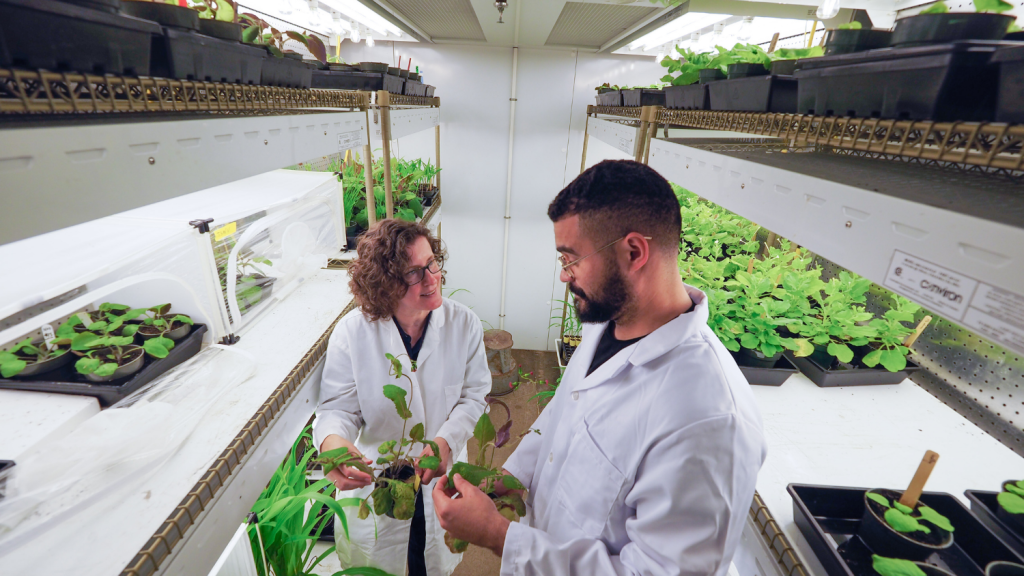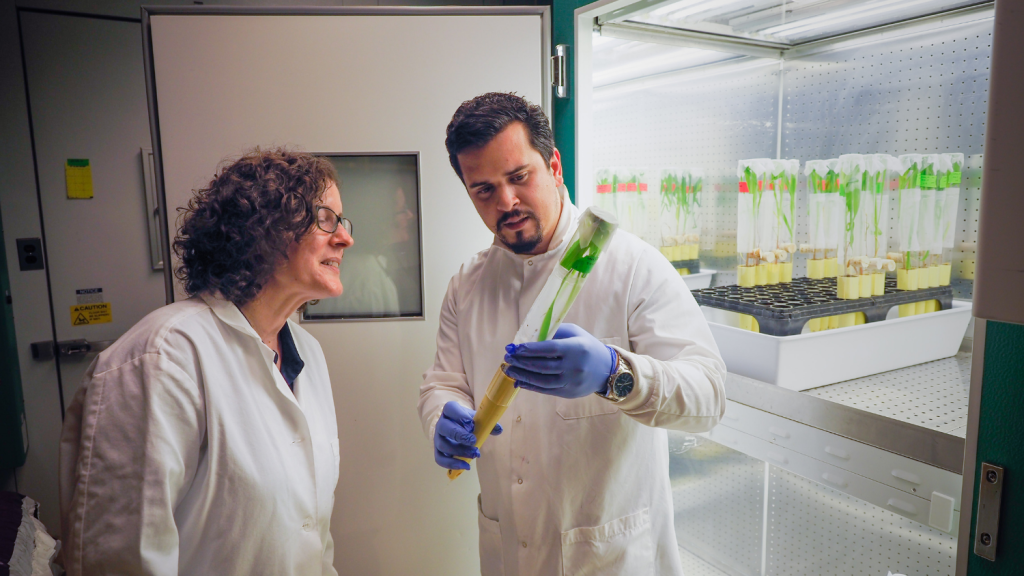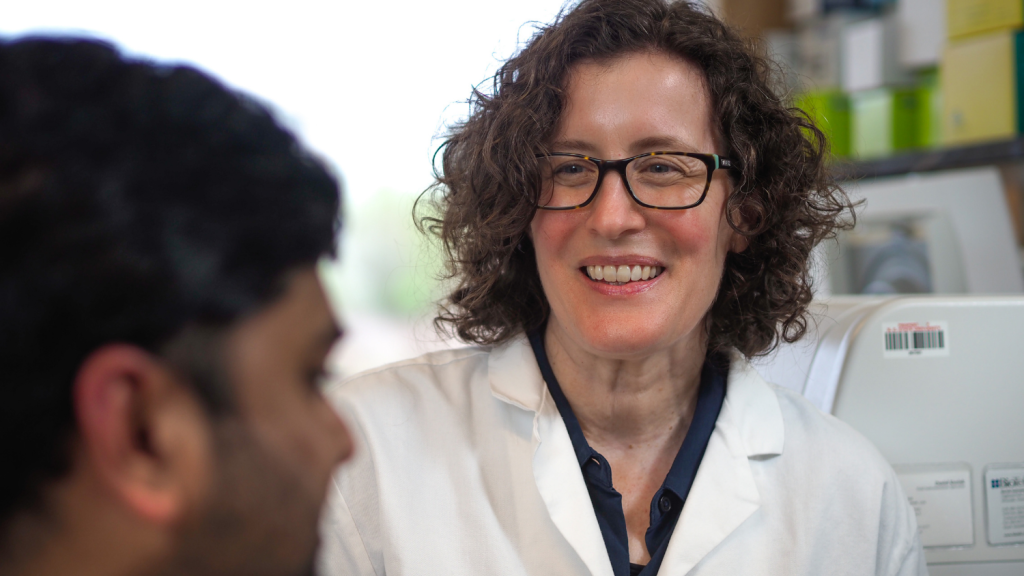By: Juliana Proffitt McCully
Anna Whitfield’s path to studying big questions in agriculture began on a small family farm in Moultrie, Ga., where she saw first-hand the economic, societal and psychological impacts of destructive plant and animal diseases.
“I study molecular virology, but my goal is always to keep one foot in the furrow,” Whitfield says. “I grew up pulling weeds out of peanuts and helping my dad feed livestock, so I feel that I really understand the plight of farmers.”
“It was a diversified farm, but there was a lot of uncertainty, and that’s what inspired my career goal to develop technologies that increase food security and reduce harm to farmworkers and the environment. I understood how drought and diseases affect crop and animal production.”
Tomato spotted wilt virus (TSWV) emerged as a significant problem when she was growing up on the farm in Georgia, and it’s now a focus of Whitfield’s lab. Additionally, when Whitfield was in her senior year of high school, a pseudorabies virus took out her father’s pig production, and he lost all of his animals.

“That was a really big deal, and you see how different diseases and stressors can totally destroy a crop and make it difficult,” she says.
Both of Whitfield’s parents are still actively engaged in managing the family farm and conversations with them continue to inform and inspire her research.
Whitfield, a plant virologist from the Department of Entomology and Plant Pathology and a faculty member in the Chancellor’s Faculty Excellence Program in the Emerging Plant Disease and Global Food Security Cluster, recently won a Bayer Crop Science Grants4Ag award for her groundbreaking research using novel viral vectors for genome editing in maize (corn) and sorghum.
The project goal is to use this technology to create plants with traits that can be beneficial to farmers, consumers and the environment. The Grants4Ag program is unique because Bayer provides project funding without any “strings attached.” The scientist and the university retain the intellectual property.
“Generally, it’s considered bad to have a virus in your plants, but this project takes plant viruses and uses them for good,” she says. “Plant viruses are powerful tools for delivering molecules to their plant hosts, so we created an infectious clone of a plant rhabdovirus that can be engineered to carry beneficial proteins or RNA to plants with the goal of protecting them from stressors such as drought, disease and pests.”
Maize is a major crop in the U.S. and worldwide, and a robust and stable virus vector could cut years off the current maize improvement pipeline.

“The ability to modify a plant phenotype in a single crop cycle can greatly facilitate identification and deployment of beneficial traits to increase crop yields and plant resilience,” Whitfield says.
The virus-based gene expression technologies have been around for years, but Whitfield’s lab is using a different class of viruses that are more stable. The project was initially supported through the DARPA “Insect Allies” program that wrapped up in 2021, and this support enabled the creation of the first efficient negative-strand RNA virus vector for maize. These negative-strand RNA viruses are more complicated, but they are also more dependable and can “carry more cargo.”
“That means you can put more genetic information into them to express different genes in plants, and they keep their inserts for a longer amount of time,” she says.
One goal for this method targets drought stress in corn; other targets are emerging plant diseases and insect pests. The viral vector can be used to provide protection from insects that feed on plants and transmit diseases.
“I believe there are innovative ways to protect the food we eat and do it in an environmentally friendly and sustainable way.”
“Instead of applying pesticides, the novel virus system could deliver a protein or RNA that could target and kill pests, which can also be better for the environment and could reduce farmworker exposure to pesticides,” Whitfield explains.
The virus can also be used for genome editing of plants as a non-transgenic approach. The virus would deliver the materials to modify the DNA of the plant and the next generation of plants would be virus-free with an altered genome.
“I think of genomic-editing technology as green biotechnology. I believe there are innovative ways to protect the food we eat and do it in an environmentally friendly and sustainable way. My hope is that the development of beneficial viruses that edit plant genomes is one of those ways.”
Growing up on a farm with well water, Whitfield remembers how her father needed a spot far enough from the well to mix pesticides so he wouldn’t risk contaminating the family’s drinking water. In some regions, she says, on top of water contamination, there is also the concern of off-target negative effects on animals. She argues that since genome-editing isn’t a chemical application like pesticide use, these types of safety concerns are greatly reduced. Instead of a piece of farm equipment that depends on fuel, the plant does all the work.

“We think about steep gas prices any time agrochemicals are applied to farmland, ” she says. “You’re using precious resources, and if you can plant a seed that’s able to protect itself, you’re saving so much money. If plants are protected from pests and drought, they will be more efficient and produce higher yields on less acreage, and therefore we can preserve land for native environments. These are the benefits I’m thinking about when I research ways to use virus vectors for crop protection.”
Another way this technology is helpful is that it’s fast.
“You normally have to go through the production of a transgenic plant, which takes a long time,” Whitfield says.“ With the virus vector technology, you deliver the virus to the plant, and in a single season, you can test different traits. It allows people to test certain genes or traits that they want to modify quickly.”
Industry partners play an important role in moving research from the lab to the field, Whitfield says, and she is thrilled to be working with them and that they see potential in the technology.
“Collaborating with industry partners will be helpful as the technology is developed because it can be deployed at a larger scale,” she says. “They have many resources. I’m a smallish lab with two scientists working on this project, but they have an enormous infrastructure. Virus vector technology could be used for crop improvement very soon in the right hands.”
Additionally, Whitfield appreciates investments in time, money and energy to answer basic science questions. The pandemic is a good example, she says, because if people hadn’t studied coronaviruses years before COVID-19 emerged, we wouldn’t have accessed vaccines and antivirals so quickly.

“It’s so important to have a pipeline of scientists working on fundamental questions,” she says.
She points to her lab’s research with TSWV as another example: “The virus replicates and infects the plants, but it also infects the insect that transmits it, and this enables us to ask some really important basic questions about the ability to infect hosts in two different kingdoms. These viruses are related to human viruses, and understanding how these insect-transmitted viruses replicate in two different hosts informs virology in general.”
For the TSWV system, Whitfield and her colleague, Dorith Rotenberg, developed tomato plants that express small pieces of viral RNA that protect them from virus infection. A basic understanding of virus biology and evolution enables them to target functional domains of the virus proteins that are highly conserved between virus isolates and species. The resulting tomato plants are resistant to TSWV and related viruses.
This resistance strategy arrives at an opportune time because a new isolate of TSWV has emerged that overcomes the resistance gene most commonly used in tomatoes. Recent experiments showed that these new tomato plants are protected from the resistance-breaking TSWV strain.
Whitfield is quick to emphasize that research isn’t a solitary endeavor, and the lab’s success requires collaboration.
“It’s important to say that I work with a great team of scientists that I’m mentoring in my lab,” she says. “It’s the post-docs, graduate students and undergrads who are actively doing the research and addressing these big questions. They are vital to everything we’re talking about today, and mentoring and training the next generation of scientists is a really important part of what I do.”
- Categories:



